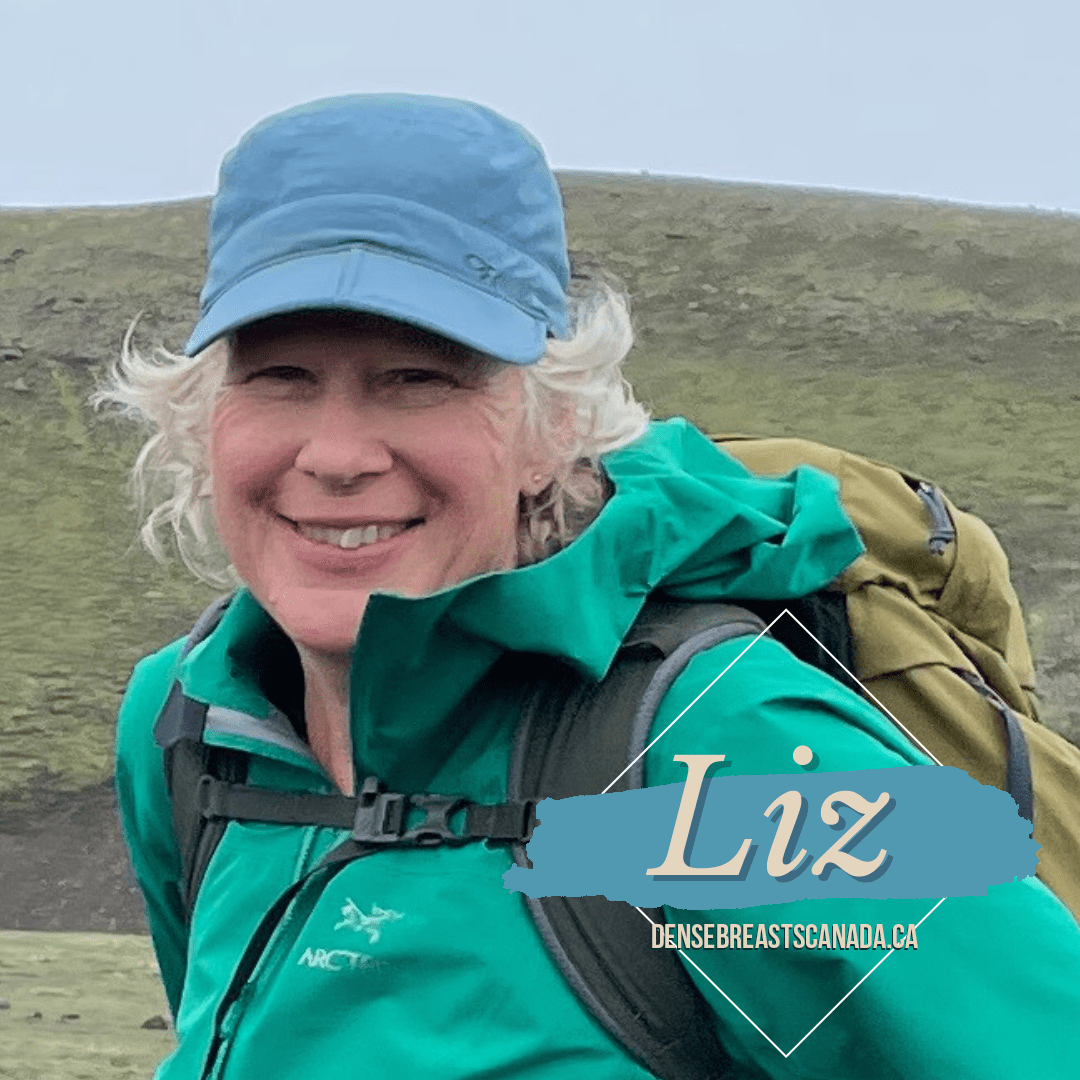Liz

One-year post breast-conserving surgery, and I want to share my story. My breast care journey began nearly 40 years ago when, in my mid-twenties, I discovered a lump in my breast. After having it removed, I anxiously awaited the results—thankfully, it was a benign cyst. Over the next decade, I underwent two more cyst removals and multiple needle aspirations, each time receiving the reassuring news that they were benign. My diagnosis was cystic breasts.
I was fortunate to have a dedicated family physician who closely monitored me. I had an initial mammogram, followed by yearly bilateral breast ultrasounds to track any changes. When I turned 40, I began undergoing an annual mammogram and continued with a yearly bilateral ultrasound. Given that my mammogram confirmed I had dense breasts and having a maternal aunt with breast cancer, I remained diligent. Before retiring, my doctor left me with one final piece of advice: Be vigilant about your breasts—don’t let your guard down.
In late October 2023, when I transitioned to a new family doctor, I requested my usual mammogram and ultrasound during our initial visit. He consulted the guidelines and stated that mammograms were recommended every two years. I requested an ultrasound, and he agreed. A few hours later, he called to inform me that guidelines suggested a follow-up in two years. Caught up in a busy workday, I initially agreed. But as I thought more about leaving my dense breasts unscreened for that long, I grew increasingly uneasy – now was not the time to take my foot off the gas. I booked a follow-up appointment.
Advocating for myself wasn’t difficult; my age, history, and dense breasts supported my case, and my family doctor was receptive by ordering a bilateral breast ultrasound. In December 2023, the ultrasound detected a suspicious lesion. A mammogram in January showed nothing concerning, but because the ultrasound revealed a suspicious mass, I was referred for a needle core biopsy. This time was different from previously biopsies, and I tried not to be overly worried. On February 20, 2024, my family doctor requested an urgent appointment. I was out of town and received the news over the phone: Invasive Ductal Carcinoma, ER+, PR-, HER2-. These biomarkers were considered favorable, but the diagnosis I had half-expected for most of my adult life was now a reality. I was devastated. I had just retired the previous summer, and my husband and I were planning a trip to Iceland in July. I was also looking forward to meeting my daughters in Vienna to see Taylor Swift. But suddenly, everything shifted. With the love and support of my family, my priorities changed, and we were hopeful for a positive outcome.
I underwent a lumpectomy and sentinel node biopsy on April 3, 2024—9mm, Stage 1, Grade 2, with no lymph node involvement. Eight weeks post-surgery, I met with a medical oncologist and radiation oncologist. A tumor sample was sent for Oncotype testing, and my blood work was analyzed for genetic mutations. My Oncotype score of 19 allowed me to avoid chemotherapy, and I tested negative for the BRCA gene. Radiation treatments were scheduled for late June. I am currently taking the aromatase inhibitor Letrozole for five years to help reduce the risk of breast cancer recurrence. In addition, I’ve started receiving Zoledronic acid infusions every six months as part of my ongoing treatment. These infusions not only help lower the chance of recurrence but also offer important protection for my bones. Early detection through supplemental screening gave me the best case scenario, and I remain deeply grateful for that.
I am very appreciative for the care I received and continue to receive. [Side note: We made it to Iceland and Vienna (but no Taylor Swift in Vienna – we saw her in Toronto)]. However, navigating the system required and continues to require significant effort on my part. As a patient, I found the medical team to be disconnected and disjointed, and I continue to manage my post-cancer care in the same fragmented environment. I have switched medical oncologists after experiencing a dismissive attitude from my previous one. My experience reinforces the critical importance of primary and supplemental screening in achieving early diagnosis and a positive outcome. Even now, I must advocate for additional screening beyond routine mammograms. The Breast Cancer Screening Centre in my hometown has declined to perform a bilateral ultrasound, despite my history. It defies logic that, as a breast cancer survivor whose cancer was never detected on a mammogram, I now find myself having to advocate for supplemental screening. I am determined to ensure that I continue to receive the necessary screening. My hope is that this understanding will grow within the breast centre in my own community, leading to better care for others in the future. Knowledge is power. The more women understand their screening options and their breast density, the better equipped they are to push for the care and follow-up needed for early detection. My story continues to unfold, and with it, my commitment to advocacy and awareness remains stronger than ever.
